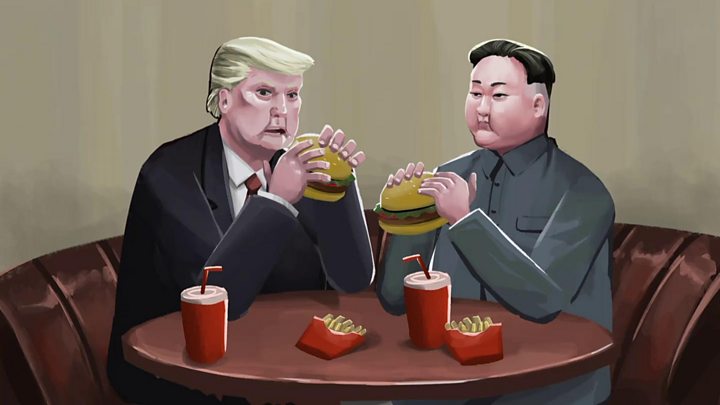This post was originally published on this site
US and North Korean officials have arrived in Sweden to restart nuclear talks in the hope of breaking a stalemate between the two countries.
The last summit between President Trump and North Korean leader Kim Jong-un ended without agreement.
Since then, there has been little progress although both sides insisted they wanted to continue negotiations.
The new talks come just days after North Korea tested a new missile in a significant step up from earlier tests.
- North Korea tests new submarine missile from sea
- Are North Korean missile tests a risk to commercial planes?
The missile, fired from a platform at sea, was capable of being launched from a submarine, which means North Korea could potentially launch missiles far outside its territory.
North Korea is banned from using ballistic missiles by UN Security Council resolutions, and is under US and UN sanctions for its nuclear programme.
The talks are taking place on the island of Lidingo, northeast of Stockholm, where US Special Representative for North Korea Stephen Biegun and North Korea’s Kim Myong Gil are expected to meet.
Why are talks happening now?
Exchanges between the sides have ranged from the cordial to frosty in the months since the summit in Hanoi which ended in failure.
But the resumption of talks comes at a crucial time – Mr Trump is under mounting pressure at home, facing possible impeachment and falling support in many opinion polls.
The North Koreans are well aware of that. They also know that they stand a much better chance of getting a deal with Mr Trump than with any other US president.
“Both sides know that the clock is ticking, with Trump up for another presidential bid next year, and the domestic political turmoil Trump is in now,” analyst Minyoung Lee of NK News told the BBC.
What to expect?
Predicting talks between the US and North Korea is notoriously difficult, says Andray Abrahamian, Senior Adjunct Fellow at the Pacific Forum.
“We’re trying, with limited information, to assess the prospects for talks between a rather esoteric and now embattled Trump Administration and North Korea, the most opaque country in the world,” he says.
After all, the last top-level talks in Hanoi surprised everyone when they suddenly fell apart. Since then there has only been a brief Trump-Kim meeting at the inter-Korean border in June.
Hanoi failed because North Korea wanted step-by-step sanctions relief while the US expected major denuclearisation steps before agreeing to ease sanctions.
“These talks are happening because there were clear signals from the US that it would be willing to discuss a phase-by-phase approach,” Ms Lee explains.
This is what North Korea has consistently called for this past year.
But Pyongyang has to be careful not to overestimate how badly the Trump administration needs a deal.
If North Korea plays hardball and threatens to walk away from a deal, “this window of opportunity might close, and close forever,” Mr Abrahamian explains.
“North Korea needs to consider that President Trump could be gone or crippled sooner than they had planned for. Time is short.”
Another Trump-Kim Summit?
Most observers see the fresh talks as an opening move to another Trump-Kim summit.
“I think that both Kim and Trump have their eye on another meeting with pageantry, but also some substance,” Mr Abrahamian says.
“It will have to be to do a deal that will be the entry point into a peace and denuclearisation process. Then the hard work begins, of course.”
The two have held two summits so far. The first one in Singapore in 2018 resulted in a vague denuclearisation agreement which led to little concrete results.
The second summit in Hanoi ended early without any agreement.

Media playback is unsupported on your device
If there was to be another summit, it would be without ousted National Security Advisor John Bolton, whose tough stance against North Korea are thought to have been a major irritation to Pyongyang.
“The US could settle for what North Korea offered in Hanoi – dismantlement of the Yongbyon nuclear reactor with US inspectors on hand,” Ms Lee expects.
“In return, North Korea likely will demand further scaling down of, or even complete termination of, all US-South Korea joint military exercises, and lifting of key sanctions.”
Reports suggest that, in the upcoming talks, the US may offer a suspension of UN sanctions on North Korean textile and coal exports for 36 months. In return, it wants the closure of the Yongbyon nuclear facility, and the end of uranium enrichment.
This is “less than the all-or-nothing approach Washington has taken so far”, Vox reports.
Didn’t North Korea just test a missile?
Just this Thursday, North Korea confirmed it test-fired a new type of a ballistic missile, a significant escalation from the short-range tests it has conducted since May.
The missile – able to carry a nuclear weapon – was the North’s 11th test this year. Fired from a platform at sea, it appears to be capable of being launched from a submarine.
The new test was “a grave moment for North East Asian regional security – and a reminder of what has been lost over nearly two years of all-show-no-substance diplomacy,” Ankit Panda, adjunct senior fellow at the Federation of American Scientists, told the BBC after the launch.
While it might have been a way to build up pressure ahead of the talks, Pyongyang is walking a tight line. The Trump administration was prepared to ignore earlier tests as they had all been short-range missiles.
This one, though, was longer and can be launched from a submarine – and hence will be much harder to brush off by the US.
